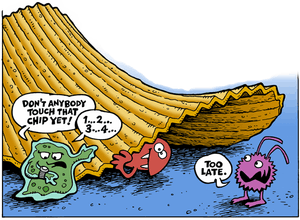Five-second rule

The five-second rule is an aspect of some Western foodways, a food hygiene practice stating that food (or sometimes cutlery) dropped on the ground will not be significantly contaminated with bacteria if it is picked up within five seconds of being dropped. Some may truly believe this assertion, whereas most people employ the rule as an amusing social fiction that allows them to eat a dropped piece of food, despite the potential reservations of their peers. The "rule" has been scientifically proven false.[1]
The time of origin of the myth is unclear.[2][3][4] Some refer to it as the three-second rule.[5]
Research
The five-second rule has received some scholarly attention[6] and has been studied as both a public health recommendation and as a sociological effect.
In 2003, Jillian Clarke of the University of Illinois at Urbana–Champaign found in a survey that 56% of men and 70% of women surveyed were familiar with the five-second rule. She also determined that a variety of foods were significantly contaminated by even brief exposure to a tile inoculated with E. coli.[7] On the other hand, Clarke found no significant evidence of contamination on public flooring.[7] For this work, Clarke received the 2004 Ig Nobel Prize in public health.[8] A more thorough study in 2006 using salmonella on wood, tiles, and nylon carpet found that the bacteria were still thriving after twenty-eight days of exposure under dry conditions.[9] Tested after eight hours' exposure, the bacteria could still contaminate bread and bologna in under five seconds, but a minute-long contact increased contamination about tenfold (with tile and carpet surfaces only).[10] A 2014 study by biology students at Aston University in England suggested that there may be a basis for the five-second rule.[11]
The five-second rule was also featured in an episode of the Discovery Channel series MythBusters. There was no significant difference in the number of bacteria collected from 2 seconds exposure as there was from 6 seconds exposure. The moisture, surface geometry and the location the food item was dropped on did, however, affect the number of bacteria.[12] Ted Allen put the rule to the test in an episode of Food Detectives,[13] and found that bacteria will cling to food immediately. High traffic areas will lead to even more bacteria on the food. Vsauce YouTube channel also dedicated a video to this topic.[14]
In a review article, a pediatrician discounted the danger in consuming certain foods dropped on to floors.[15]
Notes and references
- ↑ Anupriya, P.; Han, I.; Cox, M.; Black, C.; Simmons, L. (2007). "Residence time and food contact time effects on transfer of Salmonella Typhimurium from tile, wood and carpet: testing the five-second rule". Journal of Applied Microbiology. 102 (4): 945–953. doi:10.1111/j.1365-2672.2006.03171.x. ISSN 1364-5072.
- ↑ Sefton, Dru (2003). Intern Puts Science Behind the Five-Second Rule, Newhouse News service
- ↑ Kluck, Chad. I Think Therefore I Am: A Collection of My Thoughts, p. 35 (2000) (2000 book with reference to rule)
- ↑ (16 May 2007). Kissing Away the Germs (letter to editor), The New York Times
- ↑ (7 February 2006). Getting the dirt of the 5-second rule, Southeast Missourian
- ↑ Julie Deardorff "Capsule: The five-second rule" Los Angeles Times, August 9, 2010, accessed January 18, 2011.
- 1 2 Picklesimer, Phyllis (2003-09-02). "If You Drop It, Should You Eat It? Scientists Weigh In on the 5-Second Rule". ACES News. University of Illinois College of Agricultural, Consumer, and Environmental Sciences. Retrieved 2013-05-04.
- ↑ Winners of the Ig Nobel Prize: The 2004 Ig Nobel Prize Winners
- ↑ Dawson, P.; I. Han; M. Cox; C. Black; L. Simmons (April 2006). "Residence time and food contact time effects on transfer of Salmonella Typhimurium from tile, wood and carpet: testing the five-second rule". Journal of Applied Microbiology. 102 (4): 945–953. doi:10.1111/j.1365-2672.2006.03171.x. PMID 17381737.
- ↑ McGee, Harold (2007-05-09). "The Five-second Rule Explored, or: How Dirty Is That Bologna?". The New York Times. Retrieved 2007-05-09.
- ↑ http://www.aston.ac.uk/news/releases/2014/march/five-second-food-rule-does-exist/
- ↑ "Annotated Mythbusters: Episode 39 Chinese Invasion Alarm, 5 Second Rule". Retrieved 2008-08-17.
- ↑ "Food Detectives, Episode OF0101". Retrieved 2011-01-31.
- ↑ https://www.youtube.com/watch?v=rYXdsOEWBj0
- ↑ Aaron Carroll, "I'm a doctor. If I drop food on the kitchen floor, I still eat it." New York Times, 10 Oct 2016.